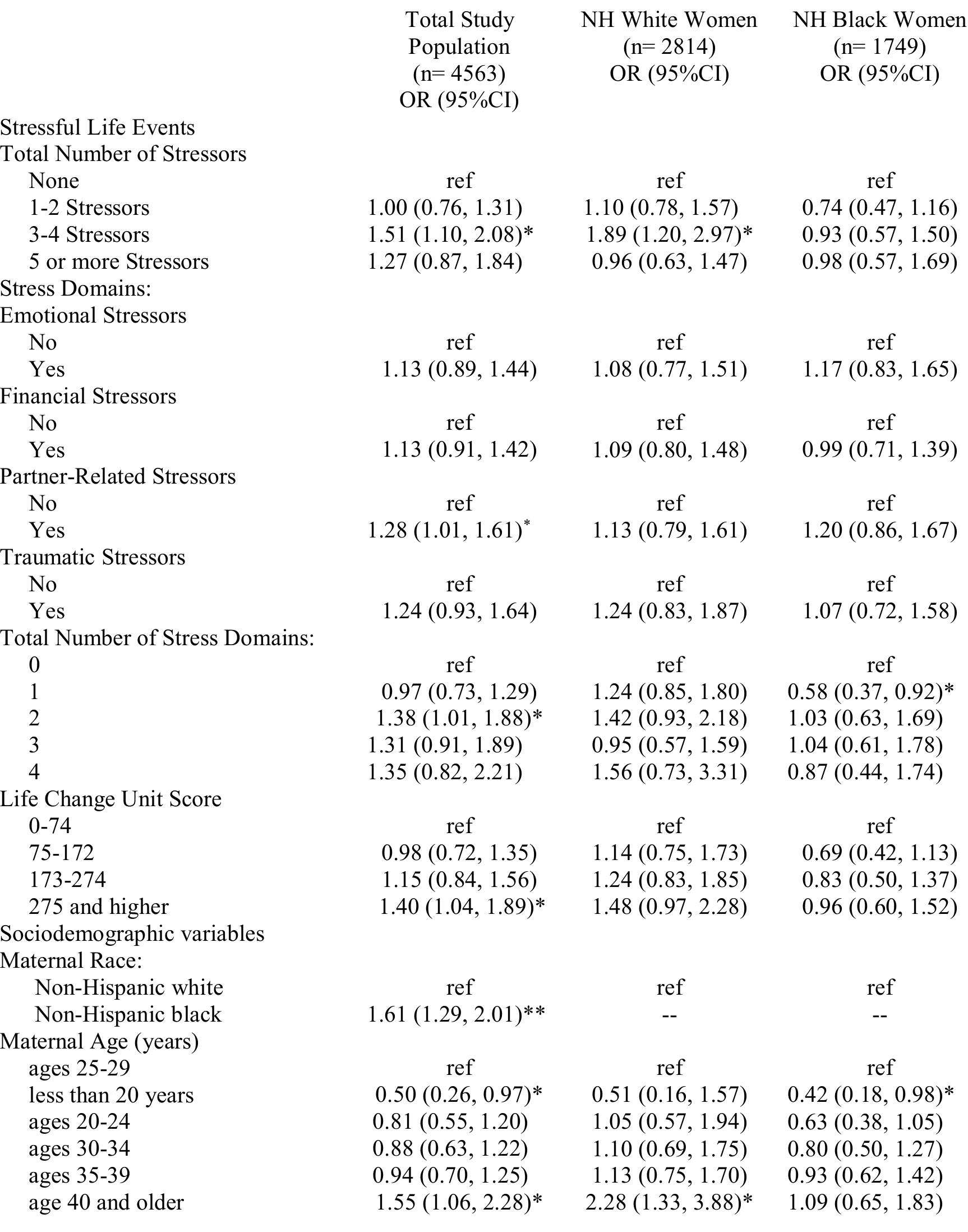Exploring Maternal Stressors and Their Relationship to Racial Disparities in Adverse Birth Outcomes in Maryland (original) (raw)
Abstract
Low birth weight and preterm birth are among the leading causes for infant mortality in the nation. Historically, infant mortality rates in Maryland have been higher than the overall rate in America due to high rates among the black population. Previous research indicates that maternal stress affects birth outcomes and may contribute to the disparity between black and white birth outcomes in the United States. The objective of this research is to examine maternal stressors experienced shortly before and during pregnancy and their relationship to disparities in low birth weight and preterm birth between Non-Hispanic black and Non-Hispanic white women in the state of Maryland. A retrospective cross-sectional analysis was conducted using Maryland Pregnancy Risk Assessment and Monitoring (PRAMS) data from 2004-2013. Bivariate and multivariate logistic regression analyses were performed to assess associations between adverse birth Chapter 1: Introduction Adverse Birth Outcomes While most pregnancies in the United States result in the delivery of a healthy infant, some deliveries result in adverse birth outcomes (Manpower Demonstration Research Corporation [MDRC], 2018). Measures of adverse birth outcomes can include: infant mortality, neonatal mortality, stillbirth, sudden infant death syndrome or SIDS, congenital anomalies, preterm birth, post-term birth, small for gestational age, low birth weight, and macrosomia. Infant mortality is when an infant dies before their first birthday and neonatal mortality describes an infant death within the first 28 days of life. Stillbirth is defined as an infant dying in the womb after at least 20 weeks of pregnancy or gestation. SIDS is the unexplained death of a seemingly healthy baby less than a year old. SIDS is sometimes known as crib death because the infants often die in their cribs while they are sleeping. Other adverse birth outcomes such as congenital anomalies are also known as birth defects and include heart defects, neural tube defects, and Down syndrome (Barkai, Arbuzova, Berkenstadt, Heifetz, & Cuckle, 2003; Dorman & Rosenberg, 1993). Preterm birth is defined as a baby born prior to 37 weeks gestation and post-term birth is when a pregnancy lasts longer than 42 weeks. Small for gestational age describes infants that are born smaller than normal for their gestational age. Low birth weight describes an infant born weighing less than 2500 grams while macrosomia occurs when an infant is born weighing more than 4,000 grams (Environmental Protection
Figures (42)
Figure 1. Conceptual Framework. preeclampsia, which is an indicator of elective delivery (Wadhwa, 2005).
Selected Maternal Characteristics and Health Behaviors by Race/Ethnicity, PRAMS, Maryland, 2004-2013 (n= 4563)
Stressful Life Events Experienced 12 Months Prior to Delivery and Birth Outcomes by Race/Ethnicity, PRAMS, Maryland, 2004-2013 (n= 4563)
Note. NH = Non-Hispanic. ref = reference group; Model covariates include: total numbe: of stressors, maternal race (for unstratified analysis only), maternal age, marital status, maternal education, pre-pregnancy body mass index, intimate partner violence, alcohol use, cigarette use, prenatal care initiation, previous preterm births, pregnancy intention,
Note. NH = Non-Hispanic. ref = reference group; Model covariates include: total number of stressors, maternal race (for unstratified analysis only), maternal age, marital status, maternal education, pre-pregnancy body mass index, intimate partner violence, alcohol use, cigarette use, prenatal care initiation, previous preterm births, pregnancy intention,
Note. NH = Non-Hispanic. ref = reference group; Model covariates include: total numbe: of stressors, maternal race (for unstratified analysis only), maternal age, marital status, maternal education, pre-pregnancy body mass index, intimate partner violence, alcohol use, cigarette use, prenatal care initiation, previous preterm births, pregnancy intention,
Note. NH = Non-Hispanic. ref = reference group; Model covariates include: total numbe of stressors, maternal race (for unstratified analysis only), maternal age, marital status, maternal education, pre-pregnancy body mass index, intimate partner violence, alcohol use, cigarette use, prenatal care initiation, previous preterm births, pregnancy intention,
Note. NH = Non-Hispanic. ref = reference group; Model covariates include: total number: of stressors, maternal race (for unstratified analysis only), maternal age, marital status, maternal education, pre-pregnancy body mass index, intimate partner violence, alcohol use, cigarette use, prenatal care initiation, previous preterm births, pregnancy intention,
Updated data when available, Excel, PDF, and more data years: Infant mortality rates and international rankings: Organisation for Economic Co-operation and Development ECD) countries, selected years 1960-2012
Note. How differential exposures to risk factors (downward arrows) and protective factors (upward arrows) over the life course affect developmental trajectories and contribute to disparities in birth outcomes. The lower reproductive potential of African American women, relative to White women, results from their cumulative exposure to more risk factors and less protective factors across the life span, particularly during sensitive periods of development. From Racial and | Perspective, March 2003, Maternal Ethnic Disparities in Birth Outcomes: A Life-Course and Child Health Journal, Vol. 7, No. 1.
human fetal developmental and health outcomes
Model 1: adjusted for all maternal characteristics and health behaviors, excluding race Model 2: adjusted for all maternal characteristics and health behaviors, including race Model 3: adjusted for all maternal characteristics and health behaviors and interaction term *p value <0.05 Multivariate analysis for associations between preterm birth and stress measures with adjustmen for maternal characteristics and health behaviors, PRAMS, Maryland, 2004-2013 (n= 4563)
Multivariate analysis for associations between low birth weight and stress measures with adjustment for maternal characteristics and health behaviors, PRAMS, Maryland, 2004-2013 (n= 4563) Model 1: adjusted for all maternal characteristics and health behaviors, excluding race Model 2: adjusted for all maternal characteristics and health behaviors, including race Model 3: adjusted for all maternal characteristics and health behaviors and interaction tert *p value <0.05

Loading Preview
Sorry, preview is currently unavailable. You can download the paper by clicking the button above.









































